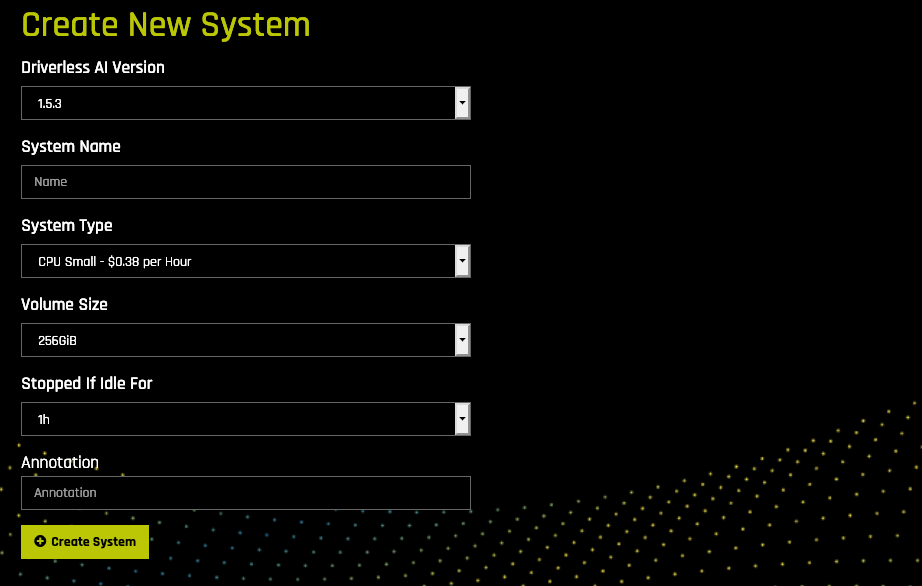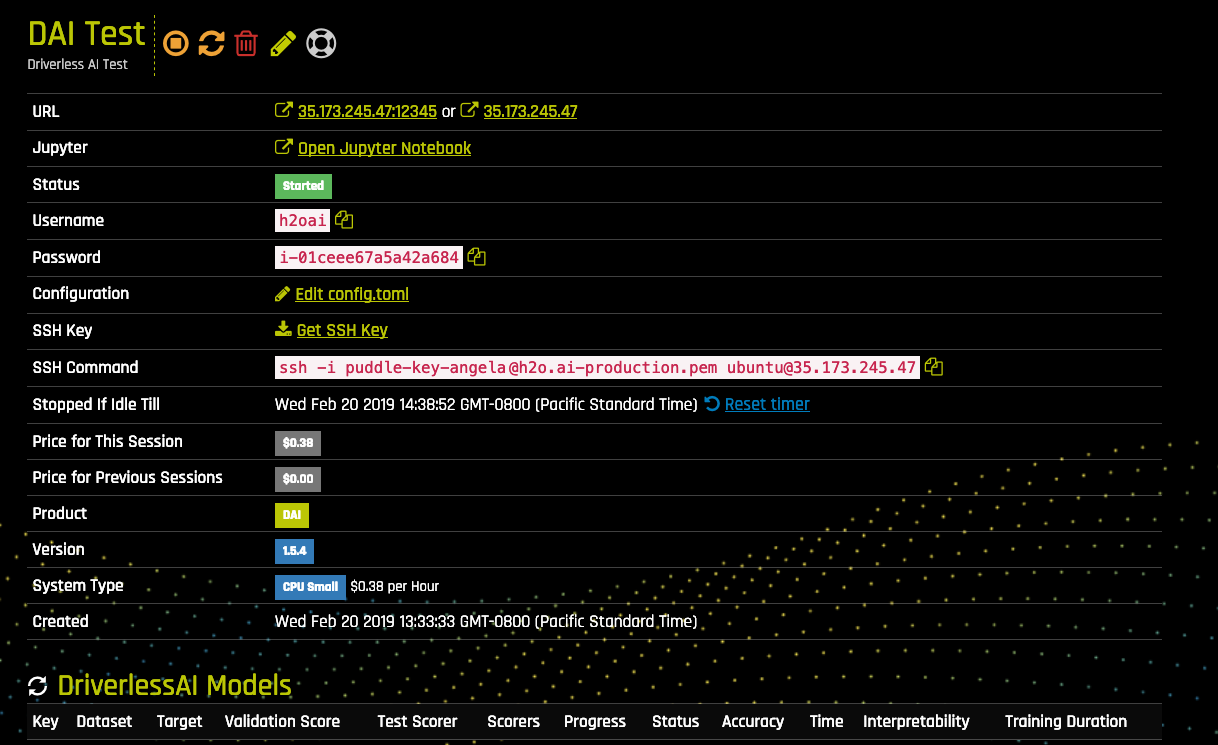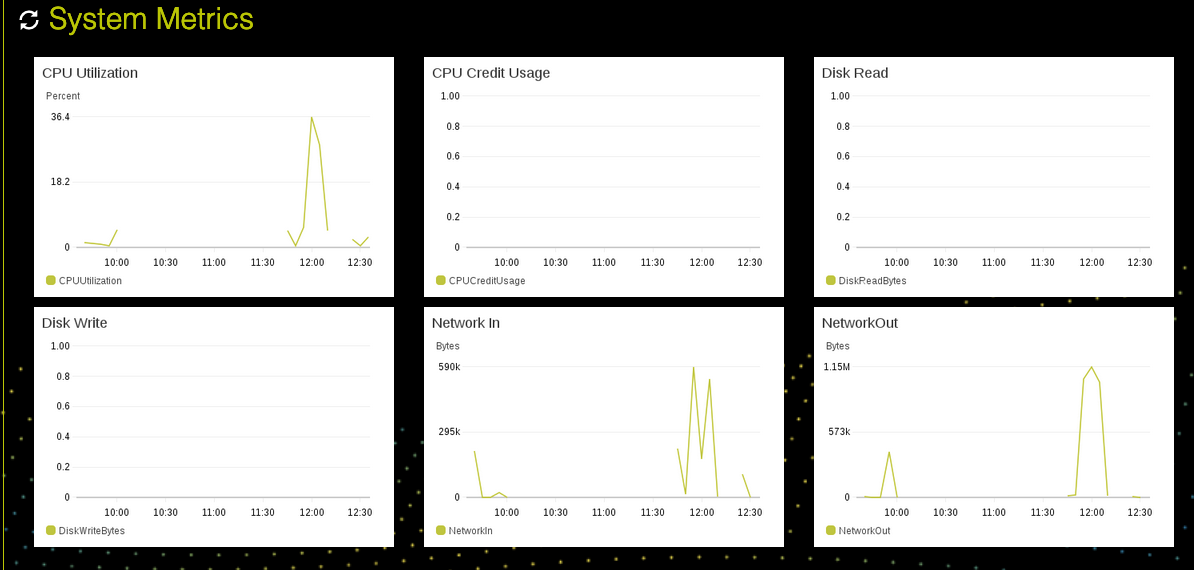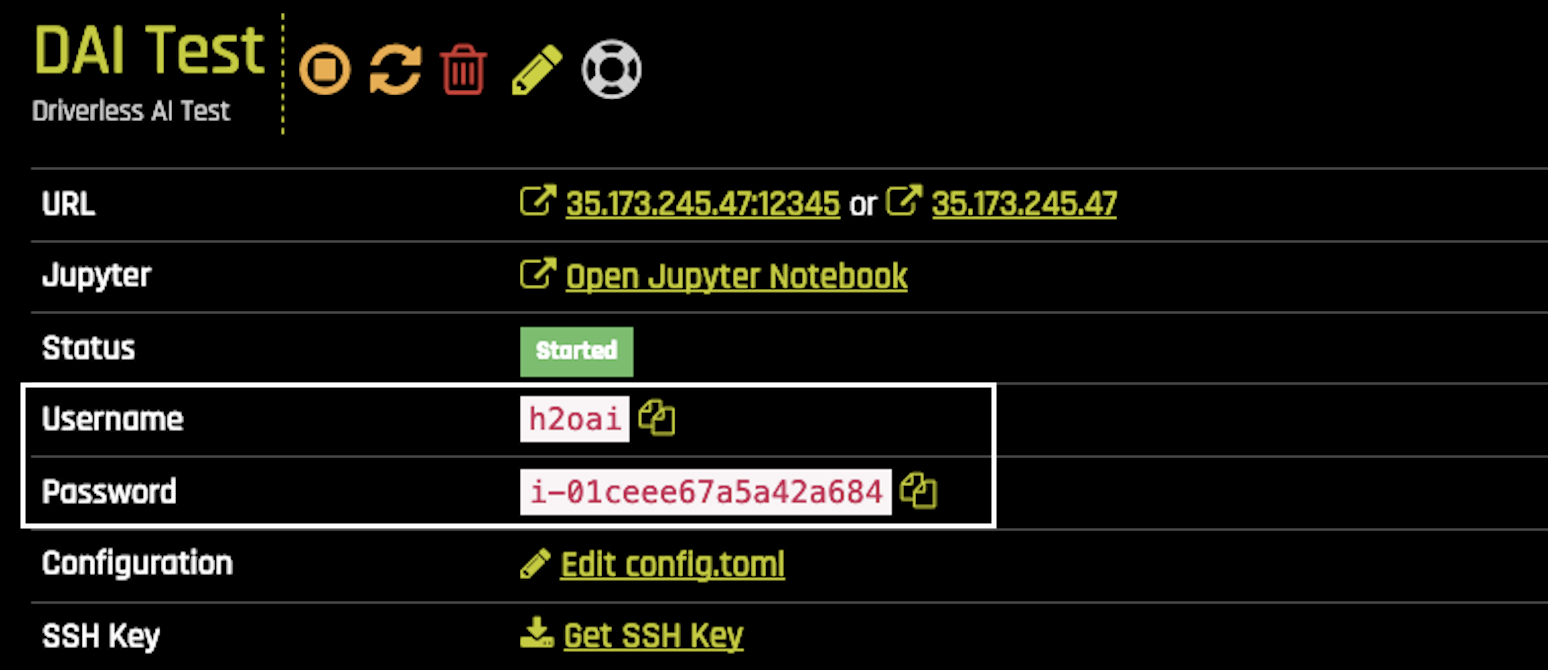Create New Driverless AI System¶
This section describes how to create a new Driverless AI system.
Notes:
- You must have a Driverless AI license in order to run Driverless AI in Puddle. You can request a free 21-day trial license at https://www.h2o.ai/try-driverless-ai/.
- Please only use public datasets during your Driverless AI evaluation on Puddle, or contact sales@h2o.ai for a private data POC.
- Click Create New Driverless AI System on the Puddle Systems page.
- Specify the following options to create the system:
- Driverless AI Version: This defaults to the most current version of Driverless AI.
- System Name: This is blank by default.
- System Type: This can be one of the following. Please also note the cost for each system type:
- CPU Small (default)
- CPU Large
- CPU XLarge
- CPU Huge
- GPU Small
- GPU Memory
- GPU Compute
Note: Your account settings may include a limit as to the number of systems of a certain type that you can run. If you exceed that limit (for example, if you exceed the number of CPU Small systems that may configure for Driverless AI), then that option will not be available, and the least expensive option will then become the default.
- Volume Size: This can be 256GiB (default), 512GiB, or 1TiB.
- Stopped If Idle For: This can be 30 min, 1 hour (default), 2 hours, 3 hours, or 4 hours.
- Annotation: Specify a description for the system. This is blank by default. It can also be edited directly on the system page.

- Click Create System when you are done. The system will begin initializing. Note that this can take several minutes.
After the system has completed initializing, you will be ready to use Driverless AI.
Viewing Driverless AI System Information¶
Click on the Driverless AI system to view the configuration information, model information for available experiments, and system metrics.

This page provides general system information, Driverless AI model information (if any models exist), and System Metrics graphs.
System Information¶
- The URL for starting Driverless AI (with and without port value). Clicking this takes you to the DNS of the URL.
- A link to open a Jupyter Notebook. This can then be used for running a Driverless AI experiment. (See Launching Jupyter Notebook below for more info.)
- The system status.
- The Username and Password for starting Driverless AI.
- A link for editing the config.toml file. The config.toml file includes all possible configuration options that can be specified when starting Driverless AI. A list of available configuration options is available in the Driverless AI User Guide.
- An SSH key for accessing the Driverless AI system. Download this key to enable secure access to this Driverless AI system. If necessary, run
chmod 400 puddle-key-<puddle_email>-production.pemto ensure that your private key file is not accessible by others. - The SSH command to run in order to securely access the system that is running Driverless AI. Be sure to update this path to point to where you stored the downloaded SSH key. (See SSH into the Driverless AI System below for more information.)
- The time when the system will stop if remaining idle. You can also reset this timer.
- The price for the current session and any previous sessions.
- The product name and version currently running on the system.
- The system type along with the cost per hour.
- The creation date.
Driverless AI Model Information¶
For each experiment run on Driverless AI through Puddle, the following information displays:
- The experiment key.
- The training dataset used in the experiment.
- The target column.
- The validation score.
- The test scorer (if a validation set is not provided).
- The scorer used for the experiment.
- The experiment progress and status.
- The Accuracy, Time, and Interpretability options used for the experiment.
- The time it took to complete the experiment (in seconds).
System Metrics¶
For each system, the following graphs are provided:
- CPU/GPU utilization graph.
- CPU/GPU credit usage (if credit was available).
- Disk Read.
- Disk Write.
- Network In.
- Network Out.
Starting Driverless AI¶
- Click on the URL provided in the Driverless AI system page. This takes you to the DNS of the URL.
- If this is your first time starting Driverless AI on this system, or if you have restarted the system, accept the license agreement.
- Enter the Username and Password that are provided on the Driverless AI system page.
- If this is your first time starting Driverless AI on this system, enter your license key. Note that if you do not have a license key, you can request a free 21-day trial license at https://www.h2o.ai/try-driverless-ai/.
Upon completion, Driverless AI will open on the Datasets Overview page. At this point, you can add or upload datasets and begin running experiments.

In Driverless AI, click on Resources > Help to view the Driverless AI User Guide. Additional documentation for Driverless AI is available at docs.h2o.ai.
Launching Jupyter Notebook¶
Puddle includes a link for quickly opening Jupyter Notebook. This can then be used for running a Driverless AI experiment using the Python client.
When you launch Jupyter Notebook from Puddle, you will see the following folders:
- data: This includes sample credit card data for running an experiment through Jupyter Notebook.
- h2oai_client_demo: This includes an example Notebook showing how to uses the Python API in Jupyter Notebook to add datasets, run and examine an experiment, and download predictions.
- notebooks: A folder for storing additional Jupyter Notebooks.
SSH into the Driverless AI System¶
Puddle provides the ability to SSH into a system that is running Driverless AI.
- Select the system that you want to SSH into.
- Download the SSH key by clicking the Get SSH Key link. Save this on your local machine.
- On your local machine, run
chmod 400 puddle-key-<puddle_email>-production.pemto ensure that your private key file is not accessible by others. (Replace <puddle_email> in the command with your Puddle at H2O email address.) - On your local machine, run the provided SSH command. If necessary, update this path to point to where you stored the downloaded SSH key.
After you are SSH’d into the Driverless AI system, you will be able to access logs, datasets, and all data stored in the tmp folder, or you can copy data into that system using scp. For example:
# SSH into the DAI machine
ssh -i puddle-key-angela@h2o.ai-production.pem ubuntu@35.173.245.47
# Review files and folders on the DAI machine
ubuntu@ip-10-10-1-53:~$ ls
config data license tmp
dai-docker-centos7-x86_64-1.5.3-9.0.tar.gz demo log
DAI_RELEASE jupyter scripts
# Open another terminal window and copy data from your
# local machine onto the DAI machine's /data folder.
# Replace the path for your pem key and dataset folder.
$ scp -i "puddle-key-angela@h2o.ai-production.pem" ~/datasets/CreditCard_test.csv ubuntu@35.173.245.47:/data
Stopping a System¶
Click the Stop button ( ) to halt the system that is in a “Started” state. No information will be lost when a system is stopped.
) to halt the system that is in a “Started” state. No information will be lost when a system is stopped.
Starting a System¶
Click on the Start button ( ) to start a system that is in a “Stopped” state. This will launch a new system with a new URL. All prior data will still be available from this URL.
) to start a system that is in a “Stopped” state. This will launch a new system with a new URL. All prior data will still be available from this URL.
Rebooting a System¶
Click the Reboot button ( ) to reboot a system that is in a “Started” state. This will stop the system and launch a new system with a new URL. All prior data will still be available from the new URL. The entire process can take several minutes.
) to reboot a system that is in a “Started” state. This will stop the system and launch a new system with a new URL. All prior data will still be available from the new URL. The entire process can take several minutes.
Deleting a System¶
Click the Delete button ( ) to completely remove a system. A confirmation page will display asking if you are certain about deleting the system. Click Yes complete the delete. This request deletes the system and destroys all data that is on the system.
) to completely remove a system. A confirmation page will display asking if you are certain about deleting the system. Click Yes complete the delete. This request deletes the system and destroys all data that is on the system.
Editing an Annotation¶
Click the Edit button ( ) to change the annotation of a system, then click Update System to complete the change.
) to change the annotation of a system, then click Update System to complete the change.
Request Support¶
Click the Request Support button ( ) or click the Request Support link on the top menu to send any issues to support. This opens the help form. Enter your issue in the form, and then click Send when you are done or click Cancel to return to the My Systems page. Responses to support requests will be sent to the e-mail address associated with your Puddle account. You can also follow up with your Sales Engagement contact.
) or click the Request Support link on the top menu to send any issues to support. This opens the help form. Enter your issue in the form, and then click Send when you are done or click Cancel to return to the My Systems page. Responses to support requests will be sent to the e-mail address associated with your Puddle account. You can also follow up with your Sales Engagement contact.



